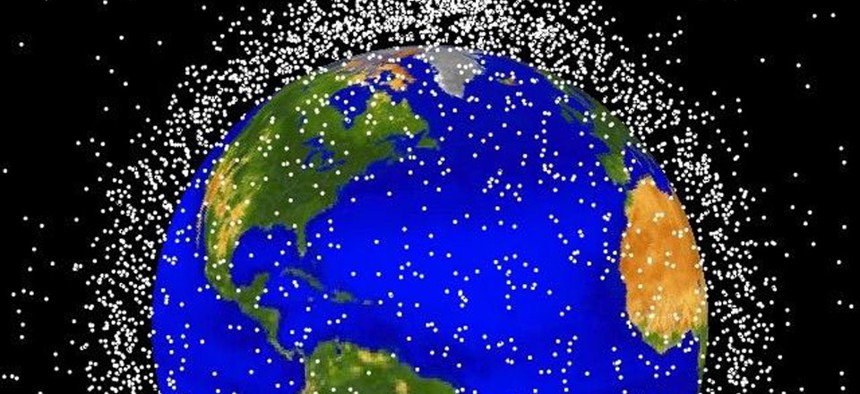Air Force to Congress: Save the Space Fence

Earth is surrounded with lots of space debris. NASA illustration
The proposal preserves development of new radars aimed at keeping vessels safe from deadly space trash.
Months after sequestration cuts shut down the country's "Space Fence," the Air Force budget unveiled Tuesday preserves $2 billion to build a successor to the program that helps keep space vessels safe from high-speed orbital debris.
For the Air Force, keeping its new radar installations off the Pentagon's budget-cut chopping block was essential. The Space Fence is part of the Air Force's Space Surveillance Network, which tracks many of the roughly half-million pieces of debris that clog Earth's orbit.
At 17,000 miles per hour, even a marble-sized object could cause catastrophic damage to a spacecraft. And one collision can cause a debris field that leads to many more—a scenario demonstrated in the movie Gravity. The Space Fence helped decrease that risk. In 2012, the network helped satellite owners make 75 maneuvers to avoid collisions.
Last September, the Space Fence—responsible for 40 percent of the network's tracking—shut down. It had been in operation since 1961. The Air Force blamed the closing on "resource constraints caused by sequestration." While the first half of that release laments the loss of Space Fence's information, the last five paragraphs hype the newer, better Space Fence, calling it key to the Air Force's future tracking ability.
So what did we lose, and what will we gain? First, the advantage of Space Fence over other programs on the Space Surveillance Network is its uncued tracking. Rather than following specific objects, it served as a "trip wire" to monitor space events, such as debris-causing collisions.
When the new Space Fence is installed, it will bring back that capability—but on a much more powerful scale. The Air Force hopes to have S-band radars ready by 2018. While the current Space Fence could see about 23,000 objects larger than four inches, something like 480,000 smaller objects still threaten spacecraft. S-band will expand our ability to see those pieces of debris.
The first S-band radar, the Air Force confirmed in its budget, will be located in the Marshall Islands, allowing better tracking of orbits that cross the Southern Hemisphere. The second is expected to be built in western Australia.
While the Air Force saved $14 million when it shut down Space Fence last year, the new-and-improved version in this year's budget will cost close to $2 billion. And the painful, short-term cuts may have had a role in preserving the program's long-heralded upgrades.
Since last year's Space Fence cuts inhibited our ability to track debris in the near-term, wrote Brian Weeden, a veteran of the Air Force's space programs, they made it that much more important to preserve that capacity in the future. By crippling the program's current operations—which Weeden says wasn't necessarily mandated by sequestration—the Air Force added pressure to the Pentagon to approve the the S-band radars and restore the early-warning system.
"The Pentagon is under significant pressure to find budget cuts and there was an internal debate over whether the S-Band Space Fence was really worth the investment," Weeden wrote in an email. "...[I]f un-sticking the roadblock to the S-Band Space Fence was the goal, then on the surface [cutting the Space Fence during sequestration] seems it may have worked." He added that there's still no proof the Air Force deliberately cut Space Fence to pave the way for its successor.
Air Force spokespeople did not immediately respond to a request for comment.





